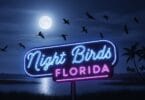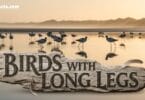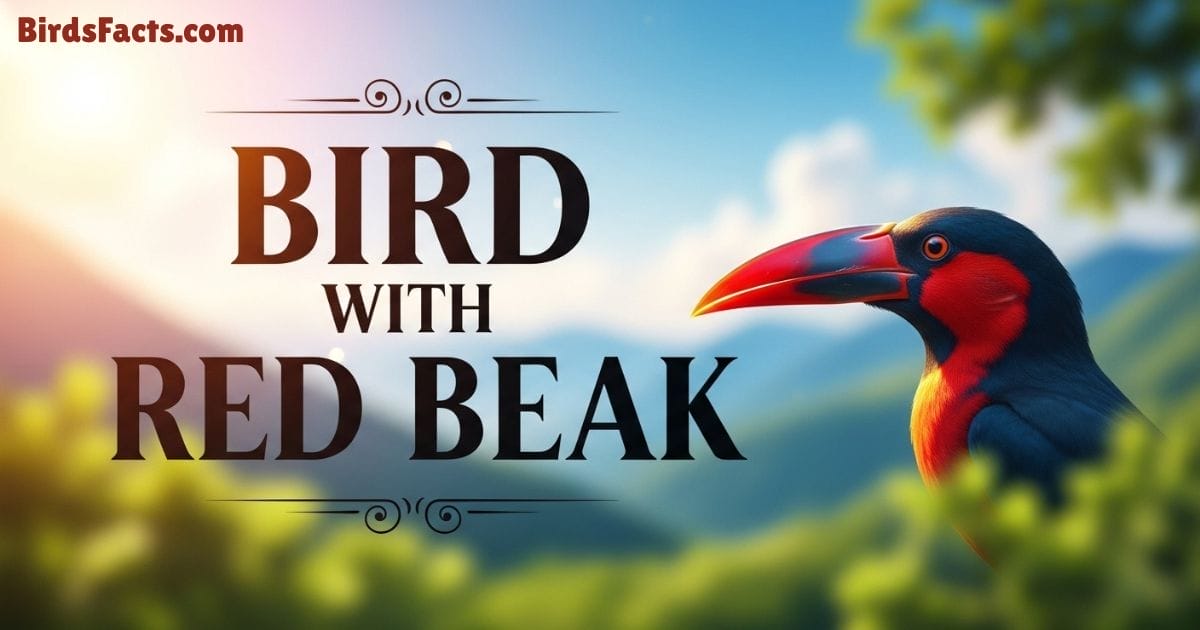
Bird with Red Beak
Have You Ever Seen A Bird with Red Beak And Wondered What It Was Called? Maybe You Spotted One In Your Garden At The Park Or While Traveling. And It Caught Your Eye Because Of Its Bright Colorful Beak. It Can Be Frustrating When You Notice Such A Beautiful Bird But Don’t Know Its Name. That Small Curiosity Often Makes People Start Searching For Answers.
A Bird with Red Beak Is Not Only Easy To Recognize But Also Very Fascinating To Learn About. Some Are Tiny And Cute While Others Are Big And Striking. In This Blog We’ll Look At Different Birds with Red Beaks Their Names And Where You Might Find Them. This Way The Next Time You See One You’ll Know Exactly What You’re Looking At.
Bird with Red Beak
- African Swamphen
- American White Ibis
- Arctic Tern
- Atlantic Puffin
- Black Oystercatcher
- Black Stork
- Black Swan
- Broad-billed Hummingbird
- Chough (Red-billed Chough)
- Common Merganser
- Common Waxbill
- Green Wood Hoopoe
- Grey-headed Kingfisher
- Inca Tern
- Java Sparrow
- Laughing Gull
- Northern Cardinal
- Purple Gallinule
- Red-billed Chough
- Red-billed Firefinch
- Red-billed Leiothrix
- Red-billed Oxpecker
- Red-billed Pied Tanager
- Red-billed Quelea
- Red-billed Scythebill
- Red-billed Tropicbird
- Red-breasted Merganser
- Red Crossbill
- Rose-ringed Parakeet
- Stork-billed Kingfisher
- Tufted Puffin
- White Ibis
African Swamphen
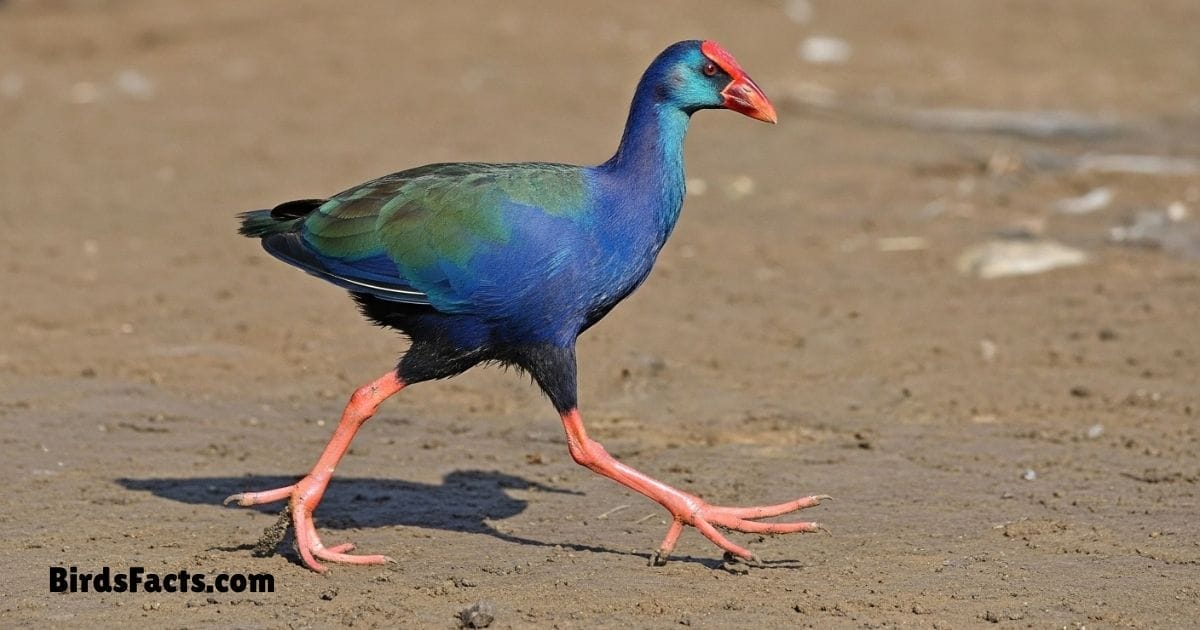
African Swamphen Walking Near Water Showing Bright Blue Plumage Red Beak And Long Legs
The African Swamphen Is A Colorful Wetland Bird with Red Beak With Deep Blue Feathers And A Bright Red Beak. Its Long Legs And Strong Toes Help It Walk Easily On Floating Plants. You’ll Often See It Near Lakes Rivers Or Marshes Foraging For Plants Insects And Small Creatures. The Striking Mix Of Colors Makes This Bird with Red Beak Stand Out In The Green Wetlands.
People Often Call It A Bold Bird with Red Beak Because Of Its Fearless Behavior. It Won’t Hesitate To Chase Away Intruders Near Its Nest. For Birdwatchers Spotting This Species Is A Real Treat Not Only Because Of Its Beauty But Also Its Lively Actions. Among Water Birds It’s One Of The Most Eye-catching Species Featuring A Red Bill.
| Facts | Detail |
|---|---|
| Range | Found In Sub Saharan Africa In Wetlands And Marshes |
| Key Fact | Known For Its Bright Purple Blue Plumage And Red Bill |
| Plumage | Purple Blue Body With Red Bill And Legs |
| Behavior | Walks On Floating Vegetation And Swims Gracefully |
| Diet | Aquatic Plants Insects And Small Invertebrates |
American White Ibis

American White Ibis Standing Near Water Showing White Body Long Red Curved Beak And Pink Legs
The American White Ibis Is Easy To Recognize With Its Pure White Feathers And Long Curved Red Beak. This Beak Isn’t Just For Looks It’s Perfect For Probing Mud And Shallow Water To Find Crayfish Insects And Small Fish. You’ll Mostly See These Birds In Wetlands Coastal Areas And Even City Parks In The Southeastern United States.
When Flying Their Long Necks Stretch Out Gracefully Making Them A Favorite Sight In The Sky. They Often Gather In Flocks Which Makes Them Hard To Miss. Many People In Florida And Nearby States See The Ibis As A Bird Of Good Luck. If You’re Searching For A Bird with Red Beak This Species Is One Of The Most Common And Beautiful Examples.
| Facts | Detail |
|---|---|
| Range | Found In Southeastern United States Central And South America |
| Key Fact | Long Curved Bill Used To Probe Mud For Food |
| Plumage | White Body With Red Bill And Legs And Black Wing Tips |
| Behavior | Often Seen In Flocks Foraging In Shallow Water |
| Diet | Insects Crustaceans And Small Fish |
Arctic Tern
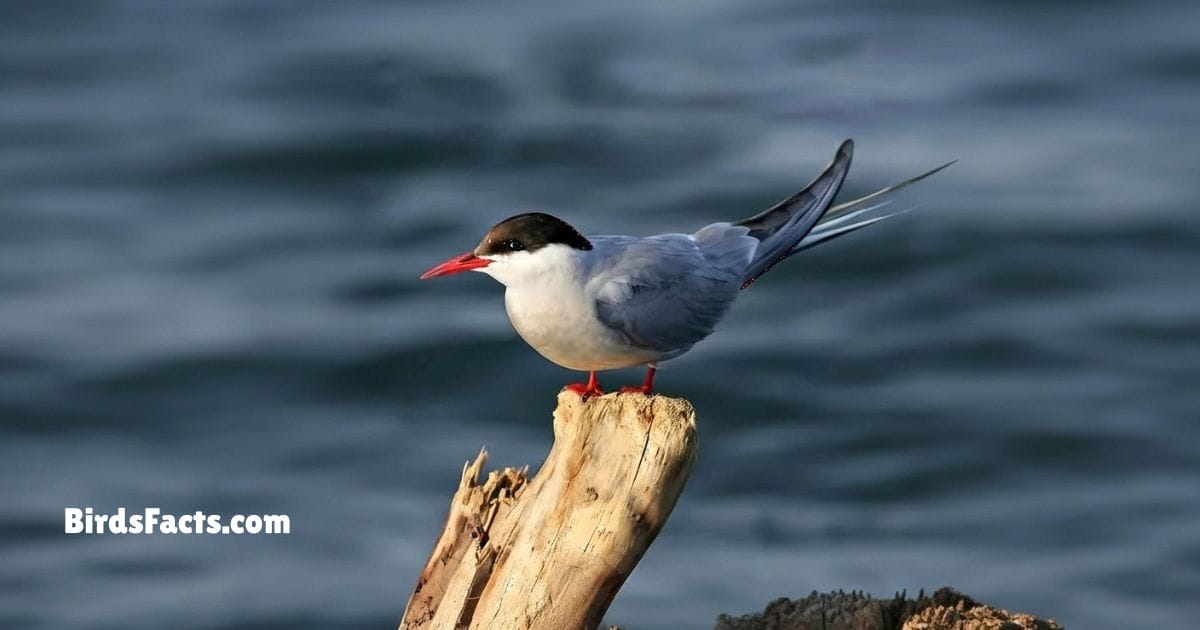
Arctic Tern In Flight Showing White Body Black Cap And Long Red Beak
The Arctic Tern May Look Small But It’s Famous For Making The Longest Migration Of Any Bird In The World. It Has A Slim Body White And Gray Feathers And A Sharp Red Beak. Every Year It Flies From The Arctic All The Way To Antarctica And Back Covering Thousands Of Miles.
This Bird Spends Most Of Its Life In The Air Feeding On Fish And Small Marine Animals. Watching An Arctic Tern Dive For Food Is Like Seeing A Dart Shoot Into The Water. Its Stamina And Bright Beak Make It A Fascinating Species For Bird Lovers. It’s A True Symbol Of Endurance Among Seabirds With Red Beaks.
| Facts | Detail |
|---|---|
| Range | Breeds In Arctic And Subarctic Regions Migrates To Antarctic For Winter |
| Key Fact | Holds Record For Longest Migration Of Any Bird |
| Plumage | White Body With Gray Wings Black Cap And Red Bill |
| Behavior | Flies Long Distances Hunting Small Fish And Invertebrates |
| Diet | Small Fish And Marine Invertebrates |
Atlantic Puffin

Atlantic Puffin Standing On Cliff Showing Black White Body And Colorful Orange Red Beak
The Atlantic Puffin Is Often Called The “clown Of The Sea” Because Of Its Colorful Bird with Red Beak And Funny Look. During The Breeding Season Its Bill Turns Bright Red Orange And Yellow Making It One Of The Most Colorful Birds In The Northern Oceans. Outside Of Breeding Season The Beak Becomes Duller But It’s Still Distinctive.
These Seabirds Are Excellent Divers And Can Flap Their Wings Underwater To Chase Fish. They Live In Large Colonies On Coastal Cliffs Especially In Iceland Norway And Parts Of Canada. Many Travelers Visit Puffin Colonies Just To See Their Bright Faces. This Bird with Red Beak Proves That Nature Knows How To Mix Beauty With Charm And Makes It Instantly Recognizable.
| Facts | Detail |
|---|---|
| Range | Found In North Atlantic Coasts Including Europe And North America |
| Key Fact | Recognizable By Its Colorful Large Bill And Clown Like Face |
| Plumage | Black Back White Belly And Bright Orange Beak And Feet |
| Behavior | Excellent Diver Swims Underwater Catching Fish |
| Diet | Small Fish And Marine Invertebrates |
Black Oystercatcher

Black Oystercatcher Standing On Rocky Shore Showing Black Body Bright Red Beak And Pink Legs
The Black Oystercatcher Is Easy To Identify With Its Jet-black Feathers And Long Bird with Red Beak. It Uses This Strong Beak To Pry Open Shellfish Such As Mussels And Clams. You’ll Usually Find It Along Rocky Shorelines Of The Pacific Coast In North America. Its Loud Calls Often Alert Birdwatchers Before They Even See It.
This Bird with Red Beak Is Considered Important For Keeping Shellfish Populations Balanced. When Standing On Rocks With Waves Crashing Behind The Bright Beak Shines Like A Signal Light. For Anyone Who Enjoys Coastal Birdwatching The Black Oystercatcher Is A Must-see Species.
| Facts | Detail |
|---|---|
| Range | Found Along Rocky Pacific Coasts Of North America |
| Key Fact | Specializes In Feeding On Shellfish With Strong Bill |
| Plumage | Black Body With Bright Orange Beak And Eyes |
| Behavior | Walks Along Rocks Probing For Mollusks |
| Diet | Mussels Clams And Other Marine Invertebrates |
Black Stork
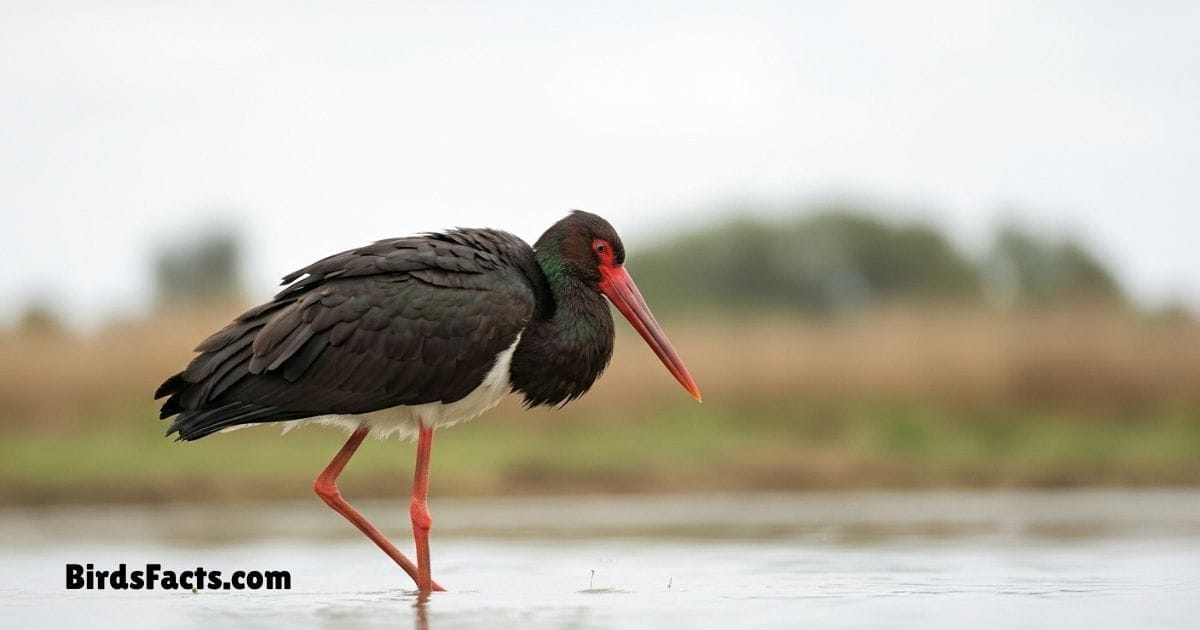
Black Stork Standing Near Water Showing Black Body White Belly Long Red Beak And Red Legs
The Black Stork Is A Tall And Graceful Bird With Glossy Black Feathers That Shine Green And Purple In The Sunlight. Its Long Bird with Red Beak And Legs Make It Easy To Spot Near Rivers Wetlands And Forests In Europe Asia And Parts Of Africa. Unlike Its White Stork Cousins This Species Is Shy And Prefers Quiet Undisturbed Areas.
It Feeds On Fish Frogs And Insects Using Its Sharp Beak To Catch Prey In Shallow Water. Seeing A Black Stork Is Considered Lucky. Since They Avoid Crowded Places And Are Rarely Seen By Casual Birdwatchers Their Mix Of Elegance And Mystery Makes Them One Of The Most Fascinating Birds with Red Beak In The Wild.
| Facts | Detail |
|---|---|
| Range | Found In Europe Asia And Africa In Wetlands And Forested Areas |
| Key Fact | Large Wading Bird With Black Plumage And Red Legs And Bill |
| Plumage | Black Back And Wings White Underparts With Red Legs And Bill |
| Behavior | Solitary Or In Pairs Often Seen Wading In Shallow Water |
| Diet | Fish Frogs Insects And Small Aquatic Animals |
Black Swan
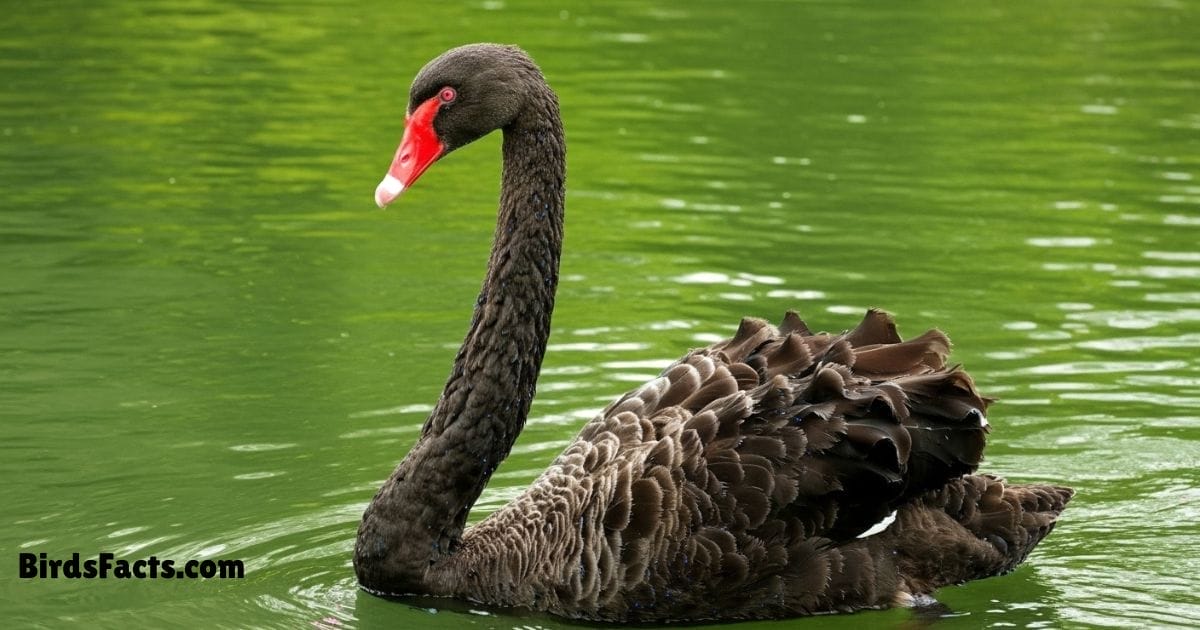
Black Swan Swimming In Water Showing Black Feathers Long Curved Neck And Bright Red Beak
The Black Swan Is One Of Australia’s Most Iconic Birds With Jet-black Feathers And A Bright Bird with Red Beak. Its Long Curved Neck And Graceful Movements Make It A True Beauty Among Waterfowl. Unlike The Common White Swans This Species Looks Strikingly Different And Almost Magical When Gliding Across A Lake.
Black Swans Live In Wetlands Lakes And Rivers Feeding Mainly On Plants. They’re Also Known For Their Strong Pair Bonds Often Staying With The Same Partner For Life. Watching A Group Of These Swans Together Is A Peaceful And Unforgettable Experience Especially When Their Birds with Red Beak Stand Out Against Their Dark Plumage.
| Facts | Detail |
|---|---|
| Range | Native To Australia Found In Wetlands Lakes And Rivers |
| Key Fact | Large Waterbird Known For Its Entirely Black Plumage And Red Bill |
| Plumage | Black Body With White Flight Feathers And Red Bill |
| Behavior | Swims Gracefully And Forms Monogamous Pairs |
| Diet | Aquatic Plants Algae And Small Invertebrates |
Broad-billed Hummingbird
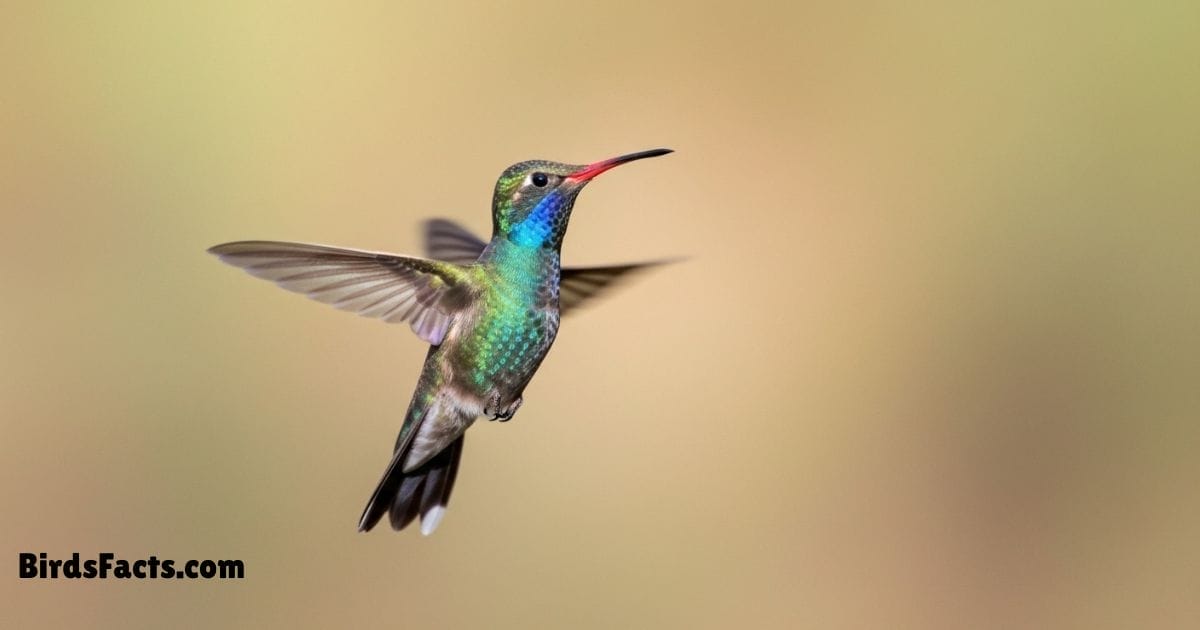
Broad Billed Hummingbird Hovering Near Flower Showing Green Blue Plumage And Bright Red Bill
The Broad-billed Hummingbird Is A Tiny Bird With Bright Blue-green Feathers And A Vivid Bird with Red Beak Tipped With Black. Found Mainly In Mexico And The Southwestern United States It’s Often Seen Darting Between Flowers. Its Wings Beat So Fast That They Create A Humming Sound Which Is Where Hummingbirds Get Their Name.
This Little Bird with Red Beak Feeds On Nectar And Also Eats Small Insects For Protein. Despite Its Size The Broad-billed Hummingbird Is Full Of Energy And Can Be Very Territorial. For Bird Lovers Spotting This Colorful Species Is Always A Highlight Especially When The Sunlight Makes Its Feathers Sparkle.
| Facts | Detail |
|---|---|
| Range | Found In Southeastern Arizona Southwestern United States And Mexico |
| Key Fact | Known For Its Extremely Bright Iridescent Green And Purple Plumage |
| Plumage | Bright Green Body With Purple Throat And Red Bill With Black Tip |
| Behavior | Hover Feeds On Nectar And Catches Small Insects In Flight |
| Diet | Nectar And Small Insects |
Chough
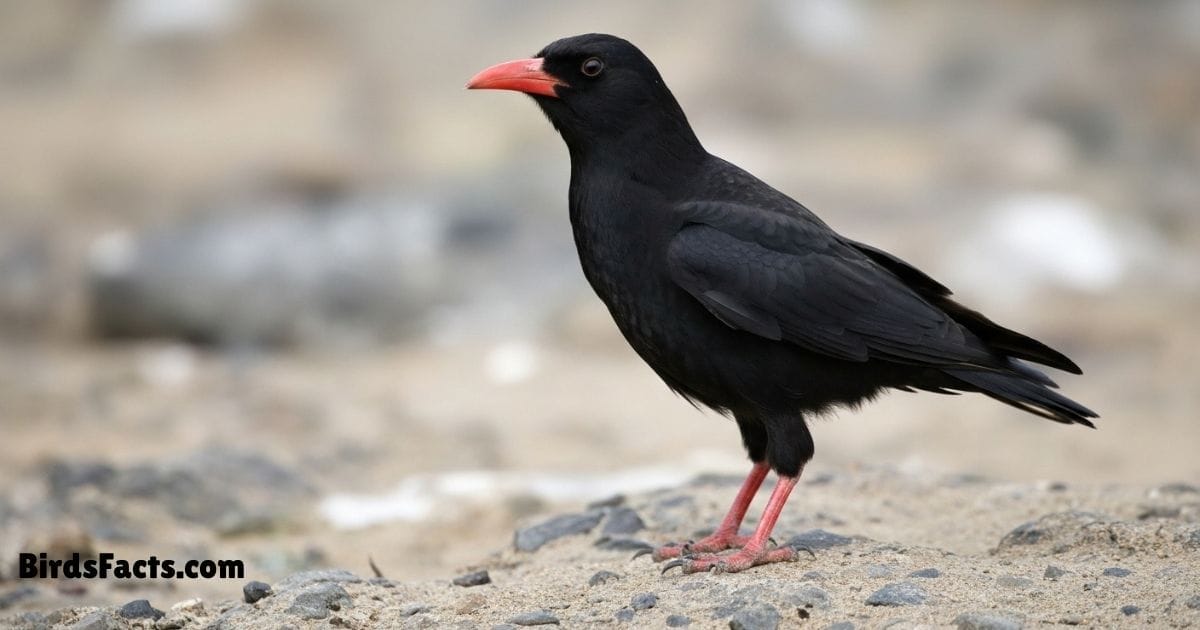
Red Billed Chough Standing On Rock Showing Black Glossy Feathers And Bright Red Curved Beak
The Red-billed Chough Is A Striking Black Bird With Glossy Feathers And A Bright Bird with Red Beak. It’s Usually Found In Rocky Coastal Areas And High Mountains Across Europe North Africa And Asia. Its Cheerful Calls And Acrobatic Flying Skills Make It Stand Out From Other Crows.
Choughs Feed On Insects Seeds And Small Invertebrates Often Probing The Ground With Their Curved Bills. They’re Also Known For Forming Close Family Groups And Displaying Playful Behavior In The Air. With Their Shiny Black Feathers And Fiery Bird with Red Beak They’re A Favorite Among Birdwatchers Who Love Coastal And Mountain Birds.
| Facts | Detail |
|---|---|
| Range | Found In Europe And Western Asia In Cliffs And Mountain Areas |
| Key Fact | Recognizable By Its Red Curved Bill And Legs |
| Plumage | Glossy Black Body With Red Bill And Legs |
| Behavior | Forages On Ground For Insects And Seeds Often In Flocks |
| Diet | Insects Seeds And Small Invertebrates |
Common Merganser
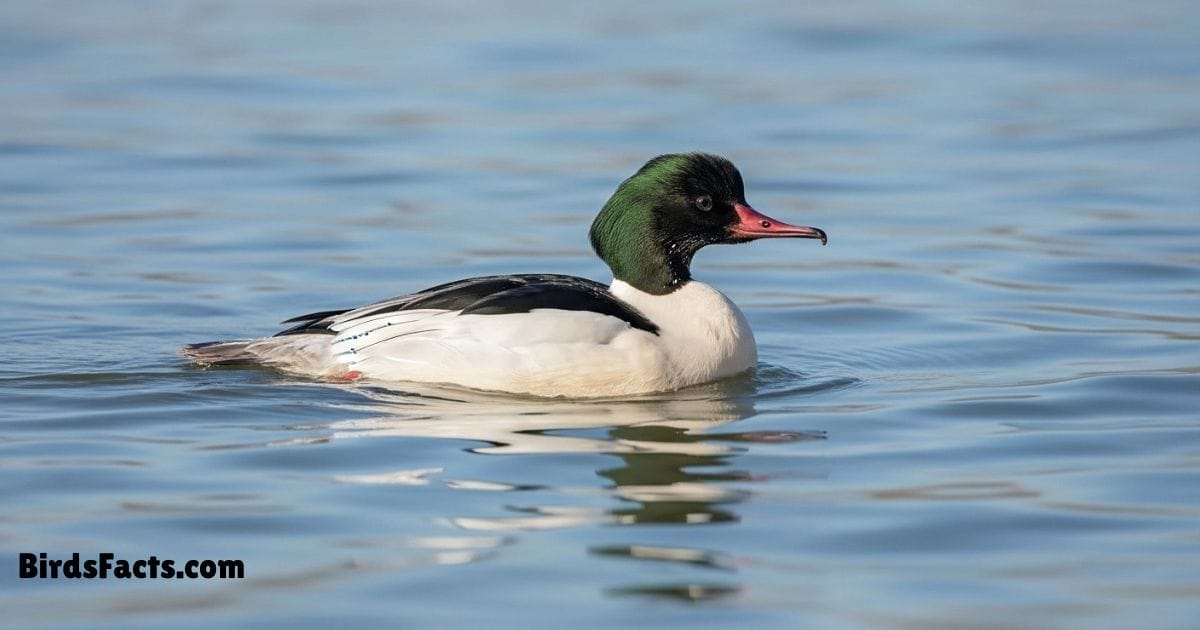
Common Merganser Swimming In Water Showing White Body Dark Green Head And Long Red Beak
The Common Merganser Is A Large Duck With A Long Narrow Bird with Red Beak That’s Perfect For Catching Fish. Males Have Striking White Bodies With Dark Green Heads While Females Show Gray Plumage With A Reddish Crest. These Birds Are Powerful Divers And Chase Fish Underwater With Speed And Skill.
They Are Often Seen Along Rivers Lakes And Forested Waterways In North America Europe And Asia. Birdwatchers Love Them For Their Sharp Hunting Style And Elegant Look On The Water. Their Bird with Red Beak Gives Them A Sleek And Stylish Appearance That Matches Their Active Lifestyle.
| Facts | Detail |
|---|---|
| Range | Found Across North America And Eurasia In Rivers And Lakes |
| Key Fact | Diving Duck Known For Serrated Bill To Catch Fish |
| Plumage | Males White Body With Dark Green Head Females Gray With Red Head |
| Behavior | Excellent Diver Often Hunts Fish Underwater |
| Diet | Fish Aquatic Insects And Crustaceans |
Common Waxbill
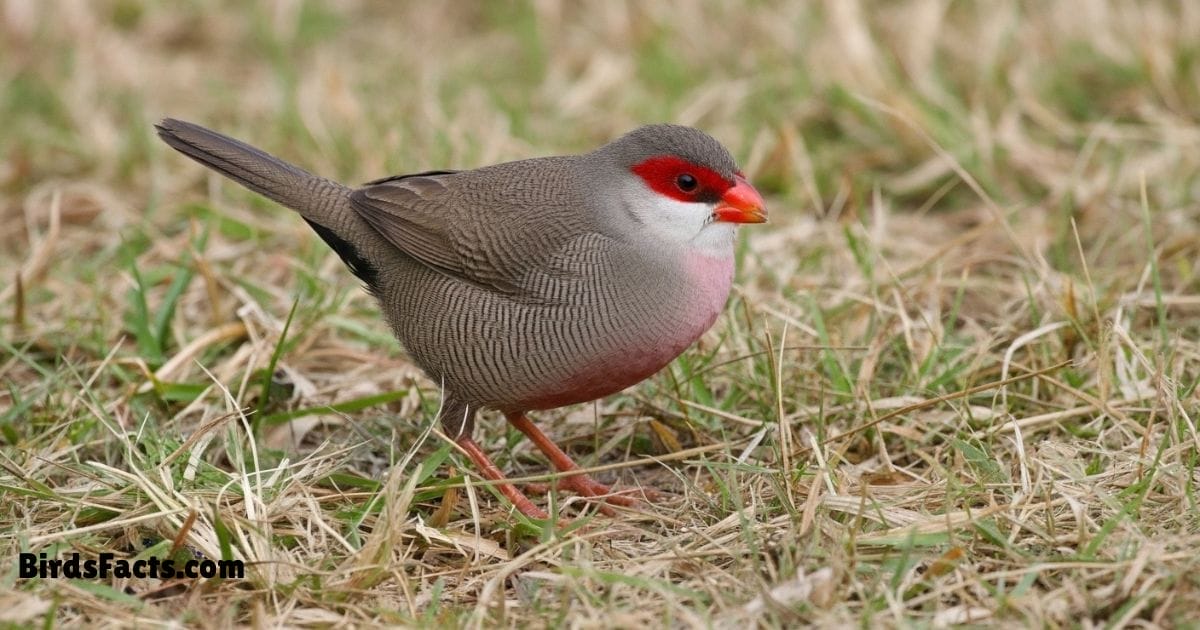
Common Waxbill Perched On Grass Stem Showing Grey Body Red Beak And Red Eye Stripe
The Common Waxbill Is A Small Delicate Bird With Gray-brown Feathers And A Bright Red Stripe Through Its Face. Its Short Bird with Red Beak Looks Almost Like Sealing Wax Which Is How It Got Its Name. Found Across Africa And In Some Introduced Populations Worldwide This Bird Is Known For Living In Flocks.
They Feed Mainly On Grass Seeds And Are Often Seen Hopping Around In Open Fields Or Wetlands. Their Cheerful Movements And Soft Calls Make Them Pleasant To Watch. Despite Their Tiny Size The Bird with Red Beak Gives Them A Bold And Colorful Look.
| Facts | Detail |
|---|---|
| Range | Found In Sub Saharan Africa And Introduced In Parts Of Europe And Americas |
| Key Fact | Small Finches Known For Red Eye Stripe And Conical Bill |
| Plumage | Grayish Brown Body With Red Stripe Across Eye And Bill |
| Behavior | Often Found In Small Flocks Feeding On Grass Seeds |
| Diet | Seeds And Occasionally Small Insects |
Green Wood Hoopoe
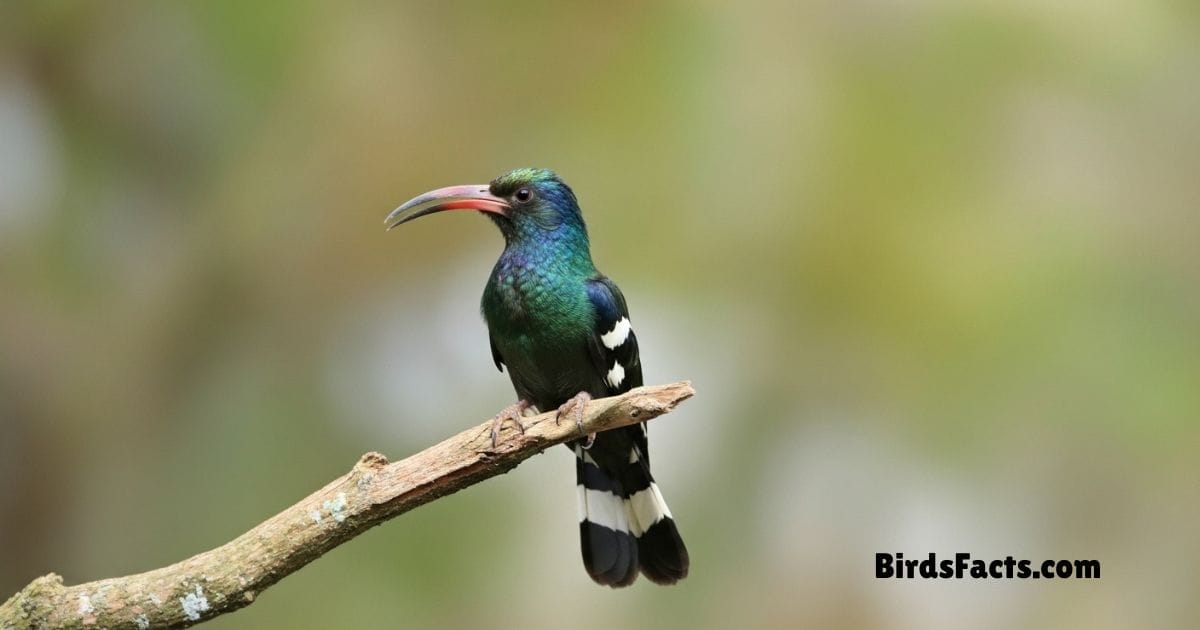
Green Wood Hoopoe Perched On Tree Showing Shiny Green Body Long Red Curved Beak And White Wing Spots
The Green Wood Hoopoe Is A Glossy Bird With Metallic Green Feathers And A Long Curved Bird with Red Beak. It Lives In African Woodlands And Savannas Often Moving In Noisy Groups. Their Sharp Calls Echo Through The Trees Making Them Easy To Hear Before You Spot Them.
These Birds Use Their Curved Bird with Red Beak To Probe Under Bark And In Crevices For Insects. They Are Highly Social And Even Perform Group Displays Where Several Birds Gather And Call Together. The Mix Of Bright Colors And Social Behavior Makes Them Unforgettable Among Exotic Birds.
| Facts | Detail |
|---|---|
| Range | Found In Sub Saharan Africa In Woodlands And Forest Edges |
| Key Fact | Known For Metallic Green Glossy Feathers And Long Curved Bill |
| Plumage | Glossy Green Body With Long Tail And Curved Bill |
| Behavior | Social Bird Often Seen Foraging In Small Groups |
| Diet | Insects And Small Invertebrates |
Grey-headed Kingfisher

Grey Headed Kingfisher Perched On Branch Showing Grey Head Bright Blue Wings And Red Beak
The Grey-headed Kingfisher Has A Soft Gray Head Bright Blue Wings And A Long Bird with Red Beak That Shines Like Coral. Unlike Some Kingfishers It Doesn’t Dive For Fish But Hunts Insects And Small Animals From A Perch. It’s Found Across Africa In Savannas Woodlands And Even Near Rivers.
This Bird with Red Beak Is Most Active During The Rainy Season When Insects Are Plentiful. Birdwatchers Admire Its Bold Colors And Sharp Hunting Skills. With Its Striking Appearance And Fiery Bill It’s One Of The Highlights Of Birdwatching In African Landscapes.
| Facts | Detail |
|---|---|
| Range | Found In Sub Saharan Africa In Open Woodlands And Grasslands |
| Key Fact | Perches Quietly Waiting To Dive On Prey With Sharp Bill |
| Plumage | Reddish Brown Body With Grey Head And Blue Wings |
| Behavior | Hunts From Perches And Often Returns To Same Spot |
| Diet | Insects Small Reptiles And Occasionally Fish |
Inca Tern

Inca Tern Perched On Rock Showing Dark Grey Body Red Beak And White Moustache Feathers
The Inca Tern Is One Of The Most Unique Seabirds Easily Recognized By Its Dark Gray Body And Bright Bird with Red Beak. Found Along The Pacific Coast Of South America Especially Peru And Chile This Bird Has A Playful And Unusual Look. Its Loud Calls And Bright Bill Make It Hard To Miss When Flying Over The Ocean.
It Mainly Feeds On Small Fish Which It Catches By Diving Into The Sea. Colonies Of Inca Terns Can Be Noisy And Full Of Activity Making Them Exciting For Birdwatchers To Observe. With Its Mustache-like Feathers And Flashy Bird with Red Beak This Seabird Is Often Described As Both Stylish And Comical.
| Facts | Detail |
|---|---|
| Range | Found Along The Pacific Coast Of Peru And Chile |
| Key Fact | Recognizable By Its White Mustache And Dark Plumage |
| Plumage | Dark Grey Body With White Curved Facial Feathers And Red Bill |
| Behavior | Nests On Cliffs And Feeds On Fish By Diving Into Water |
| Diet | Small Fish And Marine Invertebrates |
Java Sparrow
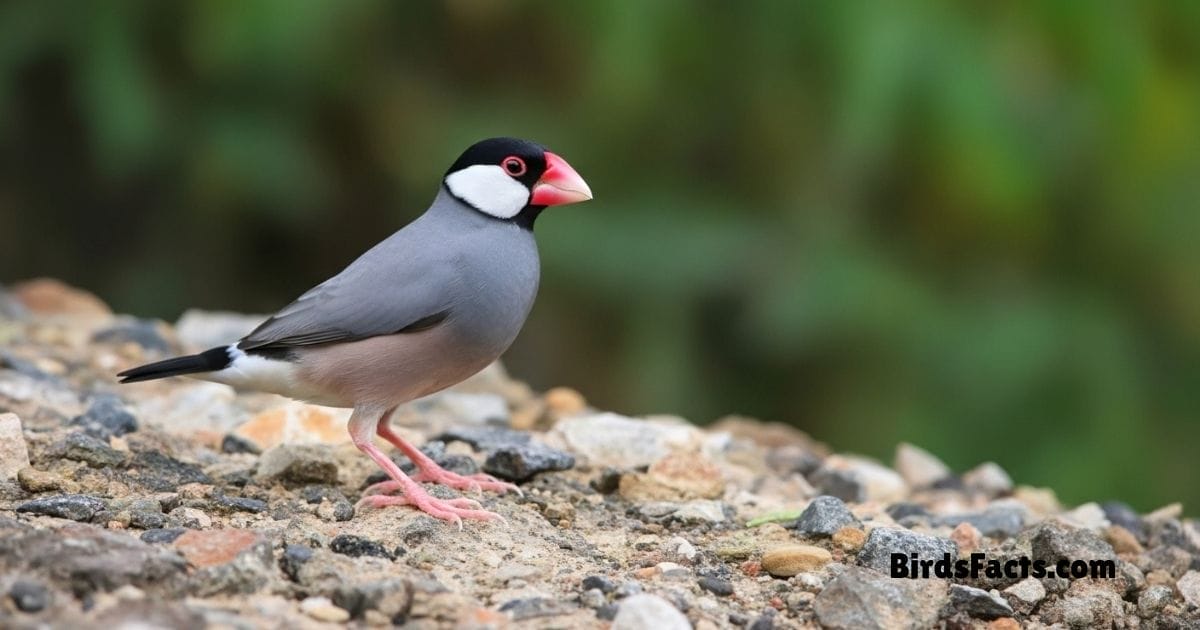
Java Sparrow Perched On Branch Showing Grey Body Pink Beak Black Head And White Cheeks
The Java Sparrow Is A Small Charming Bird With Gray Plumage A Black Head And A Bright Bird with Red Beak. Originally From Indonesia It Has Also Been Introduced To Other Parts Of The World. People Often Keep Them As Pets But In The Wild They Form Large Flocks In Grasslands And Rice Fields.
They Mainly Feed On Seeds Especially Rice Which Has Sometimes Made Them A Pest In Farming Areas. Despite This They Remain Loved For Their Beauty And Social Behavior. Their Soft Songs And Busy Flocks Make Them A Delightful Sight In Nature Or Aviaries With Their Tiny Bird with Red Beak Standing Out.
| Facts | Detail |
|---|---|
| Range | Native To Java Bali And Bawean In Indonesia Introduced Worldwide |
| Key Fact | Popular Cage Bird Known For Social And Vocal Nature |
| Plumage | Grey Body With Pink Beak Black Head And White Cheek Patches |
| Behavior | Lives In Small Flocks Often Feeding On Seeds And Grains |
| Diet | Seeds Fruits And Occasionally Small Insects |
Laughing Gull

Laughing Gull Standing On Beach Showing White Body Grey Wings Black Head And Red Beak
The Laughing Gull Is A Coastal Bird With A Sharp Bird with Red Beak White Body And Dark Gray Wings. It Gets Its Name From Its Loud Call Which Sounds Like Laughter. These Gulls Are Commonly Seen Along Beaches And Harbors In The Americas Especially During The Summer.
They Feed On Fish Insects And Even Scraps From Humans Making Them Very Adaptable. In Breeding Season Their Heads Turn Black Giving Them An Even More Dramatic Look. With Their Bright Bird with Red Beak And Lively Personalities Laughing Gulls Are Always Entertaining To Watch.
| Facts | Detail |
|---|---|
| Range | Found Along Coastal Areas Of North And Central America |
| Key Fact | Named For Its Distinctive Laughing Call |
| Plumage | Black Head During Breeding White Underparts Gray Back And Wings |
| Behavior | Often Seen Foraging Along Shorelines In Flocks |
| Diet | Fish Crustaceans Insects And Small Marine Animals |
Northern Cardinal
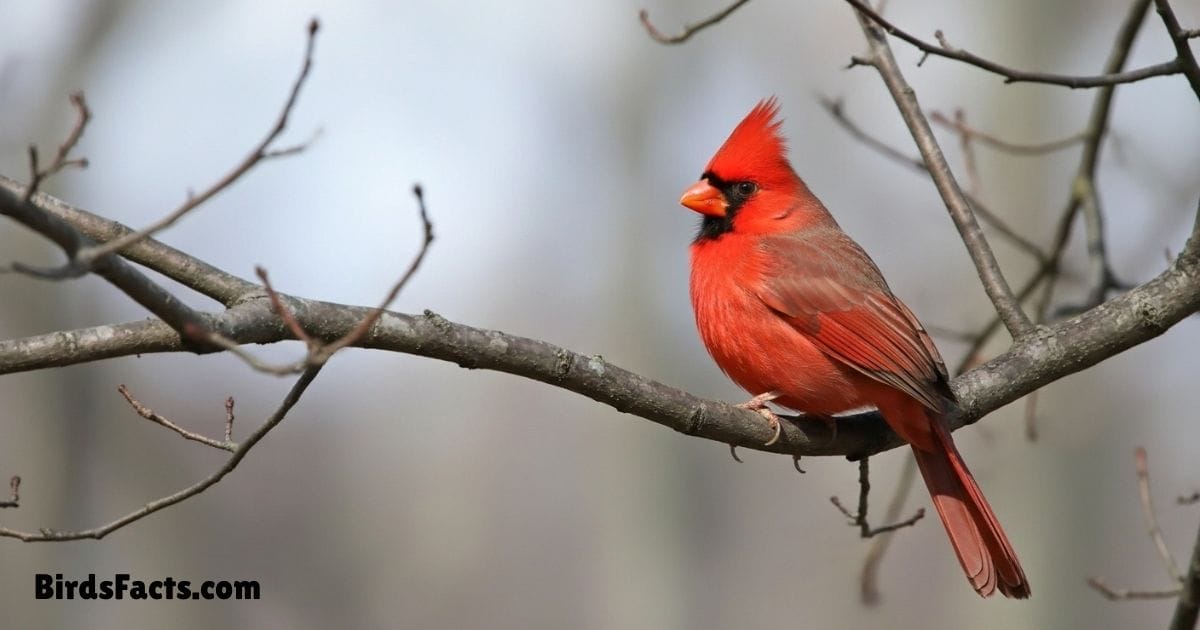
Northern Cardinal Perched On Branch Showing Bright Red Plumage Distinctive Crest And Strong Red Beak
The Northern Cardinal Is One Of The Most Beloved Songbirds In North America. Males Are Bright Red All Over With A Pointed Crest And An Orange-Bird with Red Beak While Females Are A Softer Brown With Touches Of Red. Their Sweet Whistles Are Often Heard In Gardens Woodlands And City Parks.
Cardinals Mainly Eat Seeds And Fruits Using Their Strong Bird with Red Beak Like Nutcrackers. They Are Common Year-round Making Them A Favorite For Backyard Birdwatchers. Many People See Them As A Symbol Of Hope And Beauty Especially When They Brighten Up Snowy Winter Landscapes.
| Facts | Detail |
|---|---|
| Range | Found Across Eastern And Central North America In Forests And Gardens |
| Key Fact | Male Bright Red And Easily Recognizable With Crest |
| Plumage | Males Bright Red With Black Mask Around Face Females Duller Brownish Red |
| Behavior | Sings From Perches To Defend Territory Often Seen At Feeders |
| Diet | Seeds Fruits And Insects |
Purple Gallinule

Purple Gallinule Walking On Lily Pads Showing Bright Purple Plumage Green Back Red Beak With Yellow Tip
The Purple Gallinule Is A Colorful Wetland Bird With Shiny Purple-blue Feathers Green Wings And A Bright Bird with Red Beak. It’s Often Seen Walking On Lily Pads Balancing With Its Long Yellow Legs And Big Feet. These Birds Live In Marshes And Swamps Mostly In The Southeastern United States Central America And South America.
They Feed On Plants Seeds Insects And Even Small Frogs With Their Rainbow-like Colors. They Look Almost Unreal In The Sunlight. Bird Watchers Love Spotting Them Because Of Their Unique Mix Of Beauty And Agility And Their Distinctive Bird with Red Beak Makes Them Easy To Recognize.
| Facts | Detail |
|---|---|
| Range | Found In Wetlands Of Southeastern United States Central And South America |
| Key Fact | Brightly Colored Marsh Bird With Long Toes For Walking On Floating Vegetation |
| Plumage | Purple Head And Breast Green Back Blue Wings And Yellow Bill |
| Behavior | Walks On Lily Pads And Other Floating Vegetation Searching For Food |
| Diet | Seeds Insects Small Fish And Aquatic Plants |
Red-billed Chough

Red Billed Chough Perched On Rock Showing Black Glossy Feathers And Bright Red Curved Beak
The Red-billed Chough Is A Striking Black Bird With Glossy Feathers And A Curved Bird with Red Beak. It Prefers Rocky Coasts And Mountain Cliffs In Europe Asia And North Africa. Known For Its Acrobatic Flying This Bird Often Performs Twists And Turns In The Air Almost Like A Dancer.
Choughs Feed On Insects Worms And Seeds Using Their Strong Bills To Dig Into Soil And Cracks. They Live In Family Groups And Are Very Social. Their Cheerful Calls And Fiery Bird with Red Beak Make Them Unforgettable In The Wild.
| Facts | Detail |
|---|---|
| Range | Found In Europe And Asia On Mountain Cliffs And Coastal Areas |
| Key Fact | Recognizable By Its Red Curved Bill And Legs |
| Plumage | Glossy Black Body With Red Bill And Legs |
| Behavior | Forages On Ground For Insects Often Seen In Flocks |
| Diet | Insects And Small Invertebrates |
Red-billed Firefinch
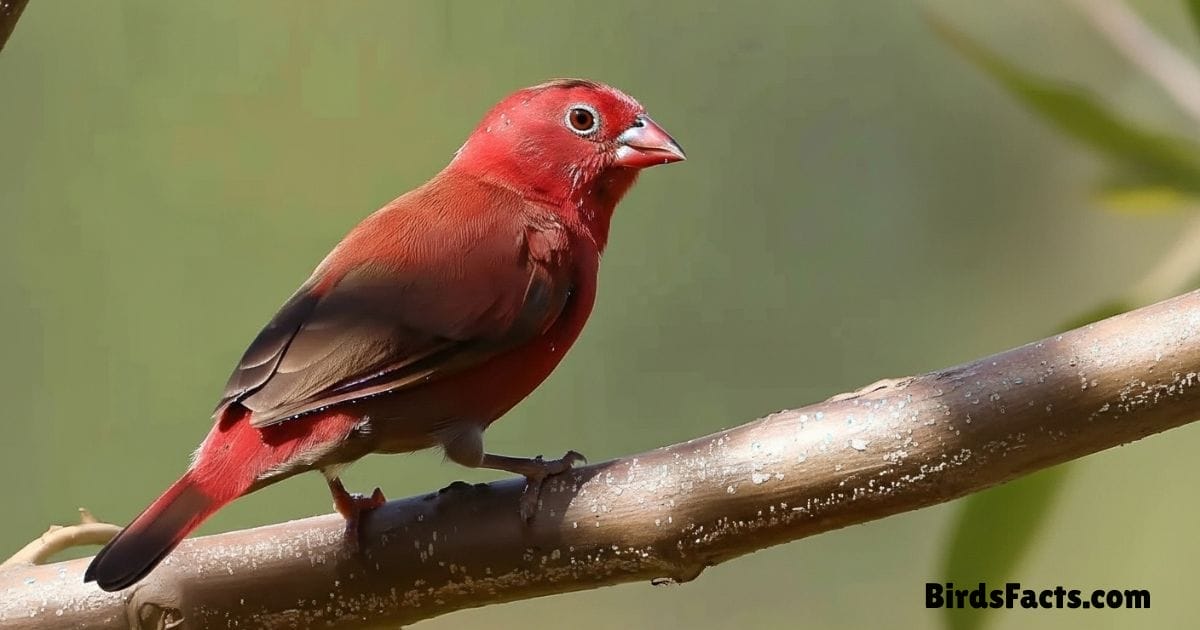
Red Billed Firefinch Perched On Grass Showing Bright Red Plumage Brown Wings And Small Red Beak
The Red-billed Firefinch Is A Tiny Beautiful Bird Found Across Africa. Males Have Bright Red Faces And Breasts While Females Are More Brown With A Touch Of Red. Their Short Bird with Red Beak Makes Them Easy To Recognize Even From A Distance.
They Feed Mainly On Grass Seeds And Are Often Seen In Pairs Or Small Groups Near Villages Fields And Gardens. Their Sweet Soft Song Adds Charm To Their Presence. Though Small These Little Finches Bring A Burst Of Color To The African Landscape With Their Bright Bird with Red Beak.
| Facts | Detail |
|---|---|
| Range | Found In Sub Saharan Africa In Grasslands And Open Woodlands |
| Key Fact | Small Finch With Bright Red Bill And Plumage |
| Plumage | Males Bright Red Females Duller Brown With Red Hints |
| Behavior | Often Found In Small Flocks Feeding On Seeds And Insects |
| Diet | Seeds And Small Insects |
Red-billed Leiothrix
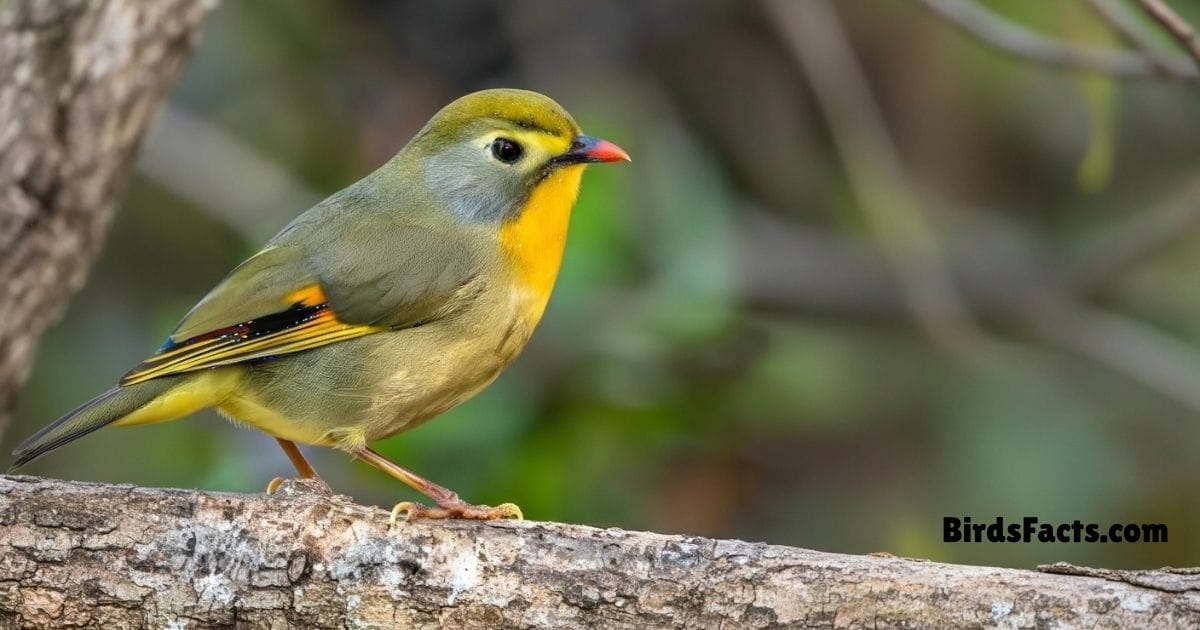
Red Billed Leiothrix Perched On Branch Showing Olive Green Body Yellow Throat And Bright Red Beak
The Red-billed Leiothrix Is A Colorful Songbird Native To Asia But Now Also Found In Other Regions Where It Has Been Introduced. It Has Olive-green Wings With Yellow And Orange Highlights And Of Course A Bright Bird with Red Beak. Its Sweet Flute-like Calls Have Made It A Favorite In Aviaries And Gardens.
This Bird Is Often Called The “Peking Robin” Because Of Its Cheerful Song. In The Wild It Lives In Forests And Scrublands Feeding On Insects Berries And Seeds. With Its Lovely Plumage And Melodic Voice It’s One Of The Most Charming Bird with Red Beak In The World.
| Facts | Detail |
|---|---|
| Range | Found In Southeast Asia In Forests And Dense Shrubs |
| Key Fact | Known For Its Brightly Colored Plumage And Melodious Song |
| Plumage | Olive Green Body With Bright Yellow Throat And Red Bill |
| Behavior | Active And Social Often Seen In Small Flocks |
| Diet | Insects Fruits And Seeds |
Red-billed Oxpecker

Red Billed Oxpecker Perched On Animal Back Showing Brown Body Yellow Eye Ring And Bright Red Beak
The Red-billed Oxpecker Is A Small African Bird Known For Its Unusual Lifestyle. It Has Brown Feathers A Bright Yellow Eye Ring And A Striking Bird with Red Beak. Instead Of Feeding On Seeds Or Insects Alone It Often Sits On Large Animals Like Buffalo Giraffes And Rhinos To Eat Ticks And Parasites From Their Skin.
This Bird Plays An Important Role In Keeping These Animals Clean Though Sometimes It Pecks At Wounds To Drink Blood As Well. It’s Often Seen In Groups Chattering Noisily While Riding On Their Hosts. For Safari-goers Spotting This Bird with Red Beak Perched On A Giant Mammal Is Always An Exciting Sight.
| Facts | Detail |
|---|---|
| Range | Found In Sub Saharan Africa On Savannas And Grasslands |
| Key Fact | Feeds On Parasites Found On Large Mammals |
| Plumage | Brown Body With Red Bill Yellow Ring Around Eyes |
| Behavior | Often Seen Perching On Cattle Or Other Large Mammals |
| Diet | Ticks And Other External Parasites |
Red-billed Pied Tanager

Red Billed Pied Tanager Perched On Branch Showing Black White Plumage And Bright Red Beak
The Red-billed Pied Tanager Is A Colorful Songbird From South America Especially Brazil. Males Are Mostly Black With White Wing Patches And A Bold Bird with Red Beak While Females Are More Brownish But Still Share The Bright Beak. They Live In Forests And Woodland Edges Where They Move Actively In Search Of Food.
These Tanagers Feed On Fruits Berries And Insects Making Them Important For Spreading Seeds In Their Habitat. They Often Travel In Pairs Or Small Flocks Flashing Their Contrasting Colors As They Move Through The Trees. Their Combination Of Dark Feathers And Bright Bird with Red Beak Gives Them A Sharp And Attractive Look.
| Facts | Detail |
|---|---|
| Range | Found In Central And South America In Forests And Edges |
| Key Fact | Striking Black And White Bird With Bright Red Bill |
| Plumage | Black And White Body With Bright Red Bill |
| Behavior | Usually Seen In Pairs Or Small Groups Foraging In Trees |
| Diet | Fruits Insects And Small Invertebrates |
Red-billed Quelea
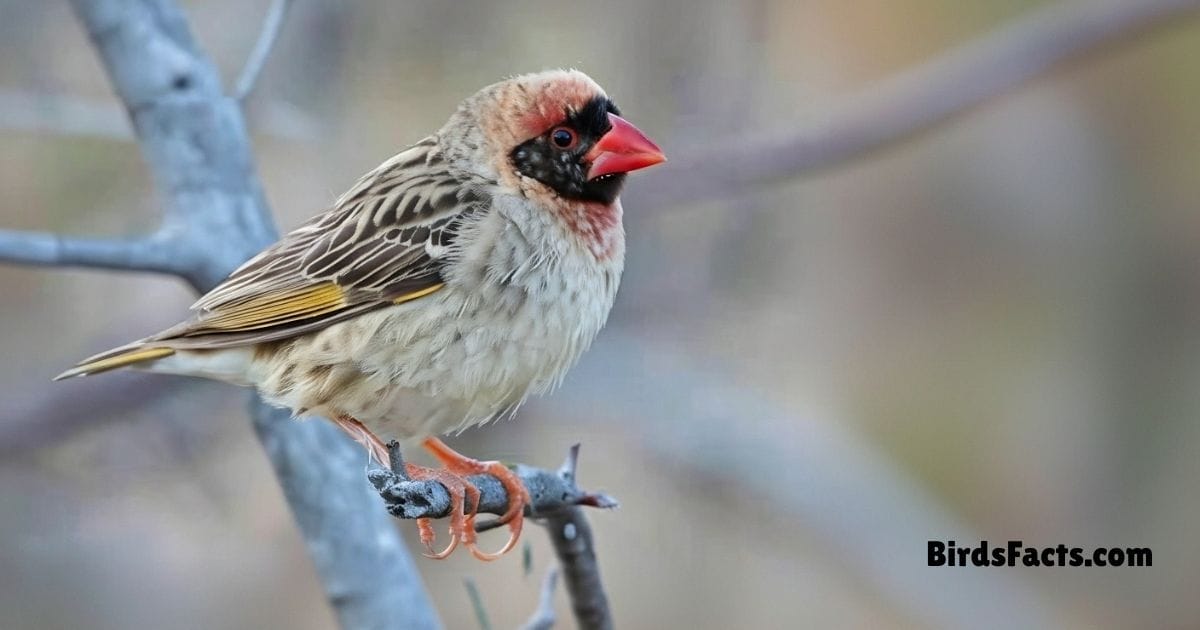
Red Billed Quelea Perched On Grass Stem Showing Small Brown Body Black Face Mask And Bright Red Beak
The Red-billed Quelea Is Often Called The Most Numerous Wild Bird In The World. Found Across Sub-saharan Africa It Has A Small Body Brownish Feathers And A Sharp Bird with Red Beak. During The Breeding Season Males Develop Black Faces And Chestnut Colors Making Them Stand Out Even More.
These Birds Are Famous For Forming Giant Flocks That Move Together Like Clouds Across The Sky. They Feed Mostly On Grass Seeds And Sometimes On Crops Which Has Made Them A Problem For Farmers. Still Their Bird with Red Beak And Synchronized Flight Patterns Are An Incredible Sight In Nature.
| Facts | Detail |
|---|---|
| Range | Found Across Sub Saharan Africa In Grasslands And Farmlands |
| Key Fact | Known As The Most Numerous Bird Species In The World |
| Plumage | Males Bright Red Bill With Brown And Buff Body Females Duller |
| Behavior | Forms Massive Flocks Feeding On Seeds Often Causing Crop Damage |
| Diet | Seeds And Grains |
Red-billed Scythebill
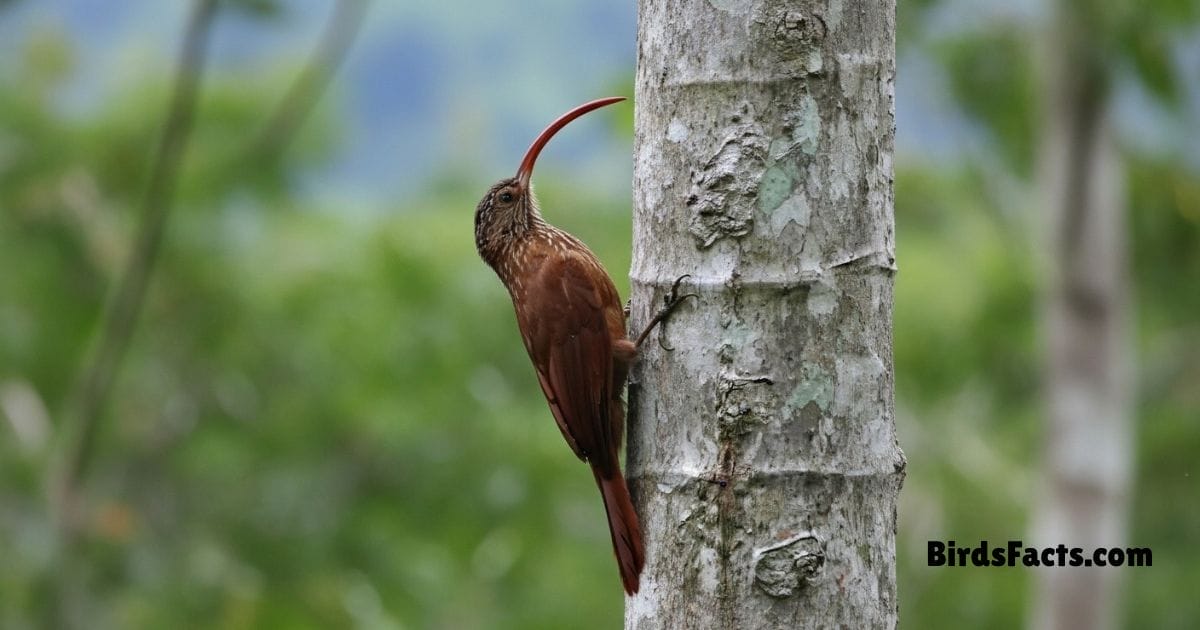
Red Billed Scythebill Clinging To Tree Trunk Showing Brown Body And Long Curved Red Beak
The Red-billed Scythebill Is A Forest Bird From South America Named For Its Long Curved Bird with Red Beak Shaped Like A Scythe. Its Brown Feathers Help It Blend Into The Trees Making The Bright Bill Its Most Striking Feature. The Beak Is Perfectly Designed For Probing Bark And Crevices To Find Insects And Spiders.
This Bird Prefers Tropical Forests And Is Often Hard To Spot Because Of Its Camouflaged Body. It Usually Climbs Tree Trunks Like A Woodpecker Moving Upward In Search Of Food. For Birdwatchers Catching Sight Of Its Unusual Curved Bird with Red Beak Is A Rewarding Experience.
| Facts | Detail |
|---|---|
| Range | Found In South American Rainforests |
| Key Fact | Named For Its Long Curved Bill Used To Extract Insects From Bark |
| Plumage | Brown Body With Slightly Streaked Underside And Long Curved Bill |
| Behavior | Clings To Tree Trunks And Probes Crevices For Insects |
| Diet | Insects And Small Arthropods |
Red-billed Tropicbird

Red Billed Tropicbird In Flight Showing White Body Black Wing Markings Long Tail Streamers And Bright Red Beak
The Red-billed Tropicbird Is A Striking Seabird Found In Tropical Oceans It Has Mostly White Feathers Long Tail Streamers And A Bright Bird with Red Beak That Makes It Easy To Recognize. These Birds Are Graceful Flyers Often Gliding Over The Open Sea In Search Of Fish And Squid.
They Usually Nest On Remote Islands Where They Lay Their Eggs In Rocky Crevices. Their Long Tails And Sharp Bird with Red Beak Give Them A Very Elegant Appearance Making Them A Favorite Among Birdwatchers And Photographers.
| Facts | Detail |
|---|---|
| Range | Found In Tropical Oceans Worldwide Nesting On Remote Islands |
| Key Fact | White Seabird With Long Tail Streamers And Bright Red Bill |
| Plumage | White Body With Black Wing Markings And Long Tail Streamers |
| Behavior | Nests In Cliffs Or Rocky Crevices And Feeds By Plunging Into Water |
| Diet | Fish And Squid |
Red Crossbill

Red Crossbill Perched On Pine Branch Showing Reddish Plumage And Distinctive Crossed Red Beak
The Red Crossbill Is A Unique Finch Found Across Europe Asia And North America. Its Bright Bird with Red Beak Is Crossed At The Tip Giving It A Very Unusual Look. Males Are Often Red Or Orange While Females Are Greenish Or Yellow But Both Share The Same Special Beak.
This Bird with Red Beak Shape Is Perfectly Designed For Prying Open Pine Cones To Eat The Seeds Inside. They Often Travel In Noisy Flocks Moving From Tree To Tree In Search Of Cones. Their Calls And Unusual Bills Make Them Easy To Notice If You’re In A Conifer Forest.
| Facts | Detail |
|---|---|
| Range | Found In Coniferous Forests Across North America And Eurasia |
| Key Fact | Specialized Bill Crossed At Tip To Extract Seeds From Cones |
| Plumage | Males Red With Dark Wings Females Greenish With Dark Wings |
| Behavior | Forages In Conifer Trees Extracting Seeds With Bill |
| Diet | Conifer Seeds |
Red-legged Honeycreeper
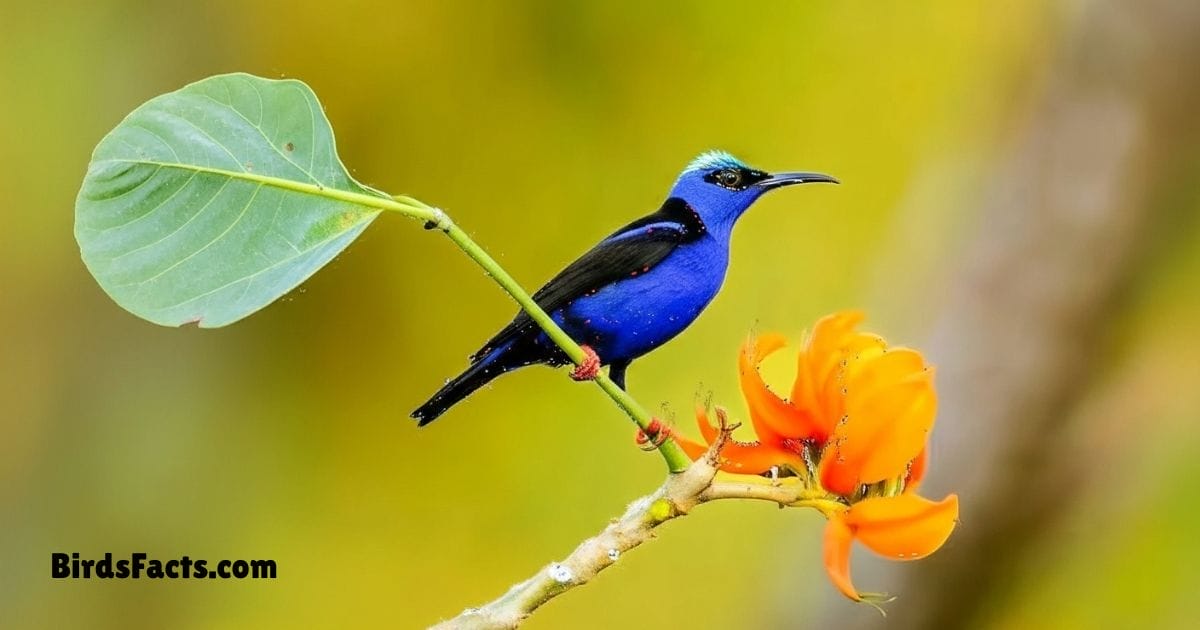
Red Legged Honeycreeper Perched On Branch Showing Bright Blue Plumage Black Mask And Red Legs
The Red-legged Honeycreeper Is A Small Colorful Bird From Central And South America. Males Are Bright Blue With A Black Mask Red Legs. And A Sharp Bird with Red Beak While Females Are More Greenish. They Are Often Seen Moving Quickly Through Trees Sipping Nectar And Eating Fruits.
These Birds Are Very Active And Often Join Mixed Flocks With Other Species Their Bright Colors .And Busy Nature Make Them A Delight To Watch. With Their Red Legs And Reddish Bird with Red Beak They Stand Out. As One Of The Most Striking Little Birds In The Tropics.
| Facts | Detail |
|---|---|
| Range | Found In Central America South America And The Caribbean |
| Key Fact | Males Display Striking Bright Blue Plumage With Red Legs |
| Plumage | Males Bright Blue With Black Wings And Red Legs Females Greenish With Blue Hints |
| Behavior | Active And Social Often Seen In Small Flocks Or Pairs |
| Diet | Nectar Fruits And Small Insects |
Vermilion Flycatcher
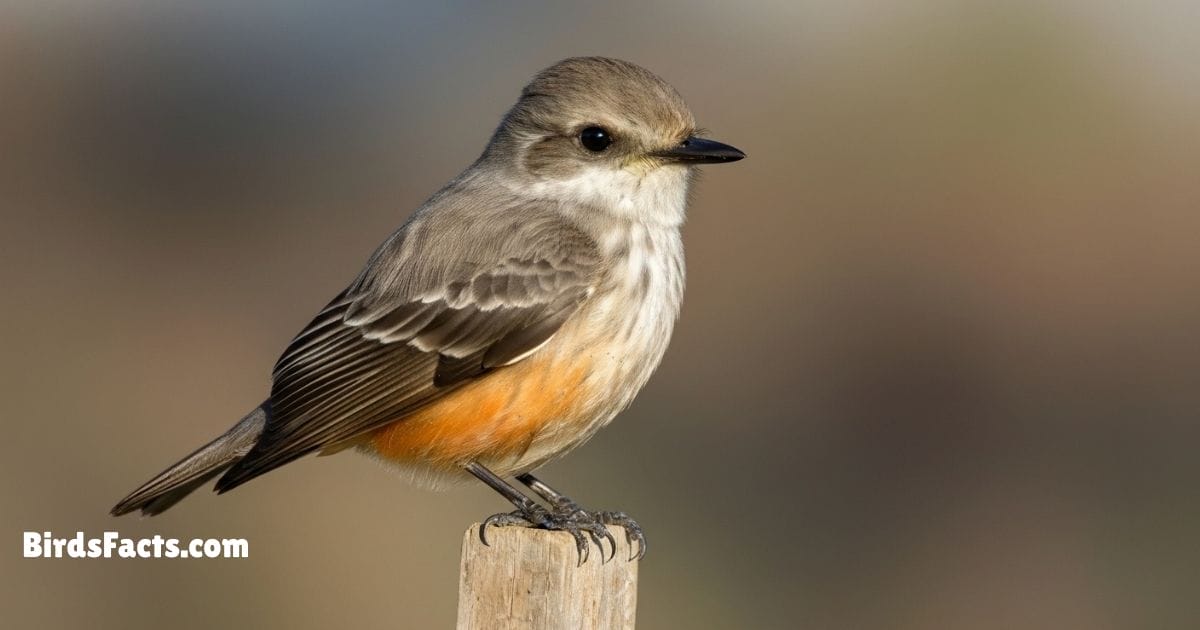
Vermilion Flycatcher Perched On Branch Showing Bright Red Plumage Dark Brown Wings And Small Black Beak
The Vermilion Flycatcher Is A Bright And Cheerful Bird Found In The Americas. Males Are Covered In Vivid Red With Dark Wings And A Sharp Bird with Red Beak While Females Are More Grayish With Hints Of Red. Their Small Beaks Help Them Catch Insects In Midair Showing Off Quick And Agile Moves.
They Are Often Seen Perched On Wires Or Branches Darting Out To Snatch Flies And Other Insects. Their Bold Red Color Against Green Fields Or Blue Skies Makes Them Look Like Flying Sparks Of Fire. The Striking Bird with Red Beak Adds Charm To Any Birdwatching Experience.
| Facts | Detail |
|---|---|
| Range | Found In Southwestern United States Mexico Central America And Parts Of South America |
| Key Fact | Males Are Brilliant Scarlet Red Making Them Easy To Spot |
| Plumage | Males Bright Red With Dark Brown Back And Wings Females Pale With Peachy Underparts |
| Behavior | Perches Openly And Flies Out To Catch Insects Mid Air |
| Diet | Insects Such As Flies Grasshoppers And Beetles |
Yellow-billed Cardinal

Yellow Billed Cardinal Perched On Branch Showing Bright Red Head White Belly Black Wings And Yellow Beak
The Yellow-billed Cuckoo Is A Slender Bird With A Long Tail And A Curved Yellow Tipped Beak. It Has Brownish Upperparts And White Underparts Giving It A Soft And Simple Look. People Often Call It The “Rain Crow” Because Its Call Is Sometimes Heard Before A Storm.
This Bird Prefers Woodlands And Thickets Where It Hunts Caterpillars Insects And Even Small Lizards. Its Secretive Nature Makes It Harder To Spot But The Distinct Bird with Red Beak Helps Birdwatchers Recognize It.
| Facts | Detail |
|---|---|
| Range | Found In South America Especially In Brazil Paraguay And Argentina |
| Key Fact | Recognized By Its Bright Red Head And Distinct Yellow Bill |
| Plumage | Red Head White Underparts Black Upperparts And Yellow Bill |
| Behavior | Often Seen In Pairs Or Small Flocks Perching On Trees Near Water |
| Diet | Seeds Fruits And Insects |
Zebra Finch

Zebra Finch Perched On Branch Showing Grey Body Orange Cheeks Black White Striped Tail And Bright Red Beak
The Zebra Finch Is One Of The Most Familiar Small Birds In Australia. Males Have Bright Orange Cheeks Black-and-white Striped Chests And A Red Beak While Females Are Plainer But Still Charming. Their Name Comes From The Striped “Zebra-like” Pattern On Their Chest And Tail.
These Finches Are Highly Social And Often Found In Large Flocks. They Feed Mainly On Grass Seeds But Will Also Take Small Insects. Because Of Their Lively Chirping And Easy Care Zebra Finches Are Always A Delight To Observe As A Bird with Red Beak.
| Facts | Detail |
|---|---|
| Range | Native To Australia And Introduced To Many Parts Of The World |
| Key Fact | Popular Pet Finch Known For Its Distinctive Black And White Face Stripes |
| Plumage | Males Have Orange Cheeks Black And White Stripes Females Plainer Gray With Orange Bill |
| Behavior | Social And Active Often Seen In Flocks And Known For Complex Songs |
| Diet | Grass Seeds Grains And Occasionally Small Insects |
Frequently Asked Questions (FAQs)
Why Do Some Birds Have Red Beaks?
Red Beaks Often Help Birds Attract Mates Signal Health Or Stand Out For Communication.
What Is The Most Common Bird With A Red Beak?
The Northern Cardinal And White Ibis Are Among The Most Commonly Seen Red-beaked Birds.
Do All Red-beaked Birds Live In Tropical Areas?
No Some Live In The Tropics But Others Like Arctic Terns And Puffins Live In Colder Regions.
Are Red Beaks Only For Decoration?
Not At All—red Beaks Are Also Strong Tools For Eating Seeds Catching Fish Or Probing For Insects.
Can I Attract Red-beaked Birds To My Garden?
Yes Planting Fruiting Plants Setting Up Feeders Or Having Water Nearby Can Bring Them Closer.
Conclusion
Birds With Red Beaks Are A Reminder Of How Amazing Nature Can Be. Their Bright Bills Don’t Just Make Them Pretty To Look At But They Also Help Them Survive. Some Use Their Red Beaks To Crack Seeds Others To Catch Fish And Many To Show Off During Courtship. No Matter Their Size Or Where They Live These Birds Bring Color And Life To Their Surroundings. Seeing One In The Wild Is Always A Special Moment For Any Bird Lover.
From Puffins On The Sea Cliffs To Cardinals In The Backyard Birds With Red Beaks Live All Around The World. Each One Has A Unique Story A Special Song Or A Striking Look That Makes It Stand Out. Watching Them Reminds Us To Slow Down And Enjoy The Little Wonders In Nature. The Next Time You Go Outside Keep Your Eyes Open. You May Be Lucky Enough To Spot A Bird With A Glowing Red Beak.



